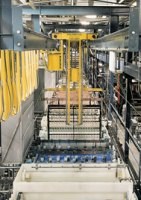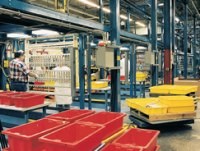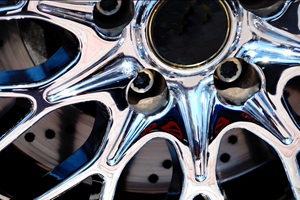High-Production Plating Line
Square D wanted its new plating line to meet the current three shifts, six days per week production in one shift, five days per week…
In 1998, Square D Company installed an automated tin plating line in its Lexington, Kentucky, facility. This new line runs both tin on aluminum and tin on copper in any product and finish mix combination. The line uses three automatic overhead hoists to run 15 loads per hour. The tin plating line not only meets Square D's current production needs, but also will meet its rapidly growing volume during the next 15 years.
Square D was founded in 1903 and now has more than 14,000 employees and more than 50 manufacturing and distribution facilities. As of 1991, Square D merged with Groupe Schneider of France to form a new worldwide organization. The Square D plant in Lexington is one of the largest in the company's network of production facilities. The Lexington plant has been operating since 1957. The present 500,000-sq-ft facility is occupied by more than 1,200 personnel. The products manufactured in Lexington include familiar household electrical service equipment, safety switches, metering equipment and components shipped to other Square D facilities for final assembly.
Square D's experienced engineering and production staff, headed by Don Smith, manufacturing engineer, and Wannie Fairchild, senior manufacturing supervisor, had many good ideas, but still wanted to explore new ideas by visiting other facilities. They visited facilities with systems designed, built and installed by several finishing system suppliers to determine the right system for Square D. Square D chose Price Walgren Company as its supplier. Square D worked with its supplier, incorporating ideas from past experiences as well as ideas from the visits to put a system together that was unique to Square D's needs. Services included a production analysis, help with rack design, ergonomics and efficiency of loading and unloading of parts, space use and process improvements as well as environmental considerations.
Square D had five major areas to address: production, safety and environment, space, equipment and process. The new line had to run what was currently taking three shifts and weekends in one shift. This amounted to running 15 loads per hour on a larger rack with a higher part density. The part number and number of pieces on a load was to be manually entered into a Panelmate (a Square D product) at each load station. The computer generated reporting was to give a shift report of part number, pieces, loads and time in and out of the machine.
The second area regarding production dealt with handling a mix of parts ranging from all tin plating on copper to all tin plating on aluminum and all proportions of product mix in between while still managing 15 loads per hour. These production demands compelled the supplier to engineer the automatic control system. The new machine meets all of these conditions while producing a high-quality product.
Square D Company had many environment and safety issues. The plating line would need to use non-cyanide chemistries, which were new to the facility. All plating chemistries must be contained in the tanks and in plumbing; nothing could be dumped onto the floor. A caustic film coming from the etch tank, used in aluminum cleaning, covered the entire plating department. The ductwork used for tank ventilation had to be Factory Mutual approved for fire. Finally, the rackers and unrackers job must be made as ergonomically friendly and safe as possible.
Square D thought the non-cyanide plating process would require a rectifier; however, it was tried on another line and worked well without it. The plating rinse water was divided into headers of like chemistries and gravity fed to waste treatment, while the dumps used transfer tanks and diaphragm pumps to reach their respective waste treatment cells. The ventilation problem causing the caustic film was eliminated using an enclosed ventilation area around the caustic etch and alkaline soak cleaner. The enclosed area was also ventilated through a scrubber system. To reduce the dragout of concentrated chemistry to waste treatment, adjustable up dwell times were used to drain plating solution from the parts back into the corresponding tanks. Counter-flow rinsing and rim sprays were used to minimize the amount of water used on the plating line.
There were several places in the racking areas where employees had been injured. This dealt with lifting and moving racks, carrying parts for distances more than necessary and racking and unracking parts using bending and reaching movements. This situation was improved by making the loading stations as part of the machine with plenty of space to move part bins closer to the racks. The bending and reaching problem was handled through the use of lowerator stations. Each racking station was hydraulically controlled to move up and down for optimum racking position without bending and reaching. The racks are stored on the machine and do not need to be removed. Because the racks are lowered into the stations automatically, a light curtain was placed around the load station, which shuts down the hoist movement if anyone is in the area under the rack. This eliminated the potential of being struck by the lowering rack.
One of the biggest engineering, production and site preparation hurdles was that the only available space for the new line was in the one existing aisle through the plating department. This aisle and surrounding peripheral equipment area was slightly more than 11-ft wide. There were many utility runs that would need to be redirected if the line was to fit into this space. Don Smith and Wannie Fairchild worked for months, first finding places for the equipment and then moving it, while trying not to disrupt production. A mezzanine was used for the rectifiers and air agitation blower. The filters, oil skimmers, scrubber recirculation tank and waste treatment pumps were the only items placed on the floor. The tanks and catwalk took up eight ft of the available 11 ft. The tanks and catwalk were prepiped and modularized prior to shipment to ease installation. All equipment is serviceable.
The controls for the line needed to use all Groupe Schneider products. This meant using the Modicon Quantum PLC and communication software. The Quantum PLC and Modbus Plus software was so new it had never been used by Square D to automate a plating line. The control system was first run at the supplier's facility to eliminate as many potential on-site problems as possible.
There were other important process considerations. The parts varied in length from three to 24 inches, and some of the parts would float when entering the solution or when air agitation was used. Square D decided to develop one rack style that would work for all parts run on the line. This would reduce the amount of space used for rack storage and would guarantee that all parts were placed on the correctly routed rack. A four-plane rack design with a part-retaining bar and bottom tray for water break was developed by a combined effort of the supplier and Square D. This rack was able to enter solution at a higher rate, enabling a higher production rate because much of the hoist time is spent lifting and lowering. The rack design also enabled Square D to use air agitation to improve rinsing and plating efficiency. In addition, the rack improved part density tremendously.
Other process considerations were that the computer control system needed to set the rectifier amperage based on the part number and pieces on a rack. The work bars with racks were not to be stored in the process tanks overnight or weekend shutdowns, so a bar storage area was put into the line layout. The tin chemistry could not use air agitation because of the oxidation potential of the stannous sulfate, so eductors were used on the discharge of the filtration system. The seven tin plating cells were combined into one mixing tank used for filtration and distributed back to all seven cells. This makes the cells one big plating bath, allowing a more consistent plating solution and requiring less laboratory analysis.
Overall, the project was a great success. All of the Square D Company's criteria for the line were met. The project was commissioned in April of 1998. The total project took seven months once a purchase order was issued.
To learn more visit Price Walgren.
Related Content
Products Finishing Reveals 2023 Qualifying Top Shops
Each year PF conducts its Top Shops Benchmarking Survey, offering shops a tool to better understand their overall performance in the industry. The program also recognizes shops that meet a set of criteria to qualify as Top Shops.
Read MoreInnovation in Plating on Plastic
Plating on advanced plastics solution offers improved adhesion, temperature resistance and cost savings.
Read MoreA Chromium Plating Overview
An overview of decorative and hard chromium electroplating processes.
Read MoreAdvantages to Pumped Eductor Agitation
Not all agitation methods are created equally. Pumped agitation with eductor nozzles can improve process tanks and quickly show a reduction in operating costs while keeping staff safe, following environmental legislation and preventing pollution.
Read MoreRead Next
Episode 45: An Interview with Chandler Mancuso, MacDermid Envio Solutions
Chandler Mancuso, technical director with MacDermid Envio discusses updating your wastewater treatment system and implementing materials recycling solutions to increase efficiencies, control costs and reduce environmental impact.
Read MoreA ‘Clean’ Agenda Offers Unique Presentations in Chicago
The 2024 Parts Cleaning Conference, co-located with the International Manufacturing Technology Show, includes presentations by several speakers who are new to the conference and topics that have not been covered in past editions of this event.
Read MoreEducation Bringing Cleaning to Machining
Debuting new speakers and cleaning technology content during this half-day workshop co-located with IMTS 2024.
Read More
























